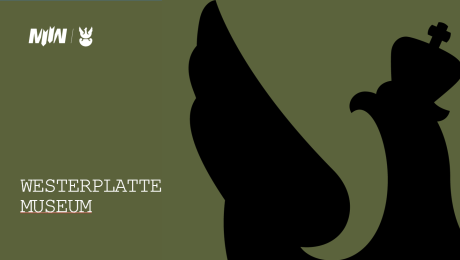Archaeological surveillance: construction of the new Polish Army Soldiers' Cemetery on Westerplatte
Duration: May 18th - October 31st, 2022; Area: Over 3500 m². Outcome: Locating and examining, among other things, three craters in the vicinity of the officer's villa and guardhouse No. 5, as well as uncovering fragments of buildings from the resort period.
The archaeological surveillance of the construction of the new Polish Army Soldiers' Cemetery on Westerplatte took place from May 18th to October 31st, 2022. The motivation for the establishment of this new cemetery was the discovery during the fifth season of excavations in 2019 conducted by archaeologists from the Museum of the Second World War in Gdańsk, of the graves of nine Polish defenders. Up to that point, the graves of soldiers who had fallen in the ruins of guardhouse No. 5 and other locations on the Westerplatte peninsula had remained hidden near the cemetery, where only symbolic graves were located. These graves were erected on the ruins of the guardhouse, where further remains or their fragments could be found. In order to conduct archaeological research, it was necessary to demolish it, work which was carried out in 2021 as part of the seventh stage of archaeological research. It was envisaged by the Museum of the Second World War in Gdańsk that the remnants of both buildings would become one of the most important elements of the emerging Westerplatte and 1939 War Museum, and their protection and exhibition were included in the concept of the cemetery's reconstruction. These objects became a significant part of its forecourt area.
The archaeological surveillance included observations of earthworks carried out on an area of over 3500 m². This area had partially been examined in the years 2016-2021, including during the eighth stage of archaeological work. The part that had not been explored before included small areas between previous excavations as well as linear, narrow excavations for electrical and telecommunication installations. In the vast majority of the area, the scope of the work (planting greenery) did not disturb the historical layers. The exceptions were excavations for the mast's foundations and five telecommunication manholes. They were excavated as part of test excavations during the investment, both because of their location on archaeologically unexplored terrain and the area allowing for the creation of complete documentation. Their total area was 32 m².
During the archaeological surveillance, three previously unknown craters were located and examined. Two of them were situated on the eastern side of the officer's villa, and the third one was to the north of guardhouse No. 5. The crater by the guardhouse and one of the objects located by the villa were the result of the impact of SC-50 bombs (weighing 50 kg) dropped by the Luftwaffe on September 2nd, 1939. The third crater was created due to the explosion of an artillery projectile or mortar grenade. These craters were filled in by Polish civilian prisoners during cleanup and demolition works ordered by the Germans after the capture of Westerplatte. In addition, two test excavations identified sections of an electrical power network that operated for the needs of Westerplatte. One of them most likely supplied power from the power plant to guardhouse No. 5. Narrow excavations also recorded fragments of masonry relics and elements of a sewage network dating from the time of the resort's operation, as well as landfill objects containing items from that period.
A total of over 5600 artifacts were obtained during the excavations, of which over 1700 were considered objects of significant historical, exhibition, or scientific value. The most valuable artifacts were found in one of the craters located near the officer's villa. They included objects related to this building, such as fragments of tableware from the Giesche Porcelain Factory, which supplied dishes for the officer's mess operating in this building. Among these artifacts were other valuable items, such as a glass Christmas tree bauble depicting St. Nicholas, a fragment of the Polish encyclopedia "Ultima Thule," two bottles of Troika cologne, and packaging for Polish-made cosmetics, hygiene products, and medical items. Of particular value is a plastic template used to apply symbols to oil lamps. Due to the place of discovery, it can be assumed that the object belonged to the Westerplatte commandant, Major Henryk Sucharski, or his deputy, Captain Franciszek Dąbrowski. Other valuable items include two Polish soldier's canteens showing signs of damage, likely caused by shrapnel impact and the pressure from an explosion. They probably belonged to defenders serving in guardhouse No. 5. In its vicinity, a magazine for a Browning wz. 28 hand machine gun and an angular rod from the set of tools for the Polish heavy machine gun wz. 30 were found. An extremely valuable artifact is also an eagle from the 19th regimental cap of the Toruń garrison, marked with the number 63, denoting the 63rd Infantry Regiment from Toruń, which was part of the 4th Infantry Division. Historical sources indicate that soldiers from Toruń served on the peninsula from 1926 to 1933.
On November 4th, 2022, at the new Polish Army Soldiers' Cemetery, a solemn burial ceremony took place with the participation of state authorities. Major Henryk Sucharski, whose remains had been exhumed from an Italian cemetery and had rested on Westerplatte since 1971, was buried, along with soldiers found during the 2019 archaeological excavations: Corporal Adolf Petzelt, Corporal Bronisław Perucki, Corporal Jan Gębura, Senior Private Władysław Okrasa (Okraszewski), Senior Legionary Zygmunta Zięba, Senior Legionary Ignacy Zatorski, Legionary Józef Kita, and two as yet unidentified defenders of Westerplatte.











